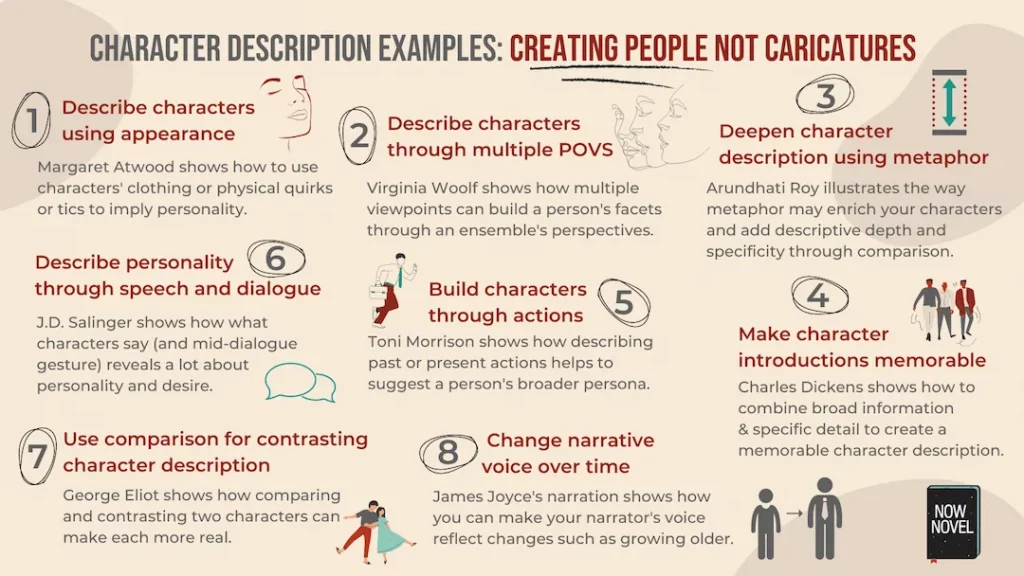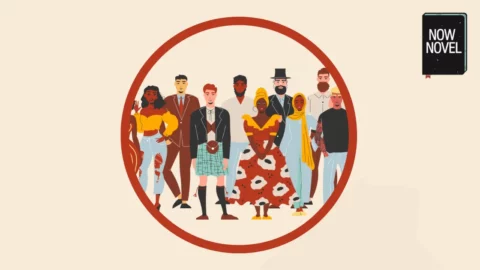Great character descriptions demonstrate how fiction has the power to make invented characters feel like old friends. Ernest Hemingway once wrote, ‘When writing a novel a writer should create living people; people not characters. A character is a caricature’. Read examples of character description that build character and persona, plus takeaways from each excerpt. These pointers will breathe life into your fictional characters. Before you start however, consider creating a character profile, and include tons of details about them in it.
Character description examples and what they teach us
The character description examples below show how to:
- Describe characters using appearance
Margaret Atwood shows how to use characters’ clothing to imply personality.
- Describe characters through multiple POVS
Virginia Woolf shows how multiple viewpoints can build a person’s many sides through an ensemble’s perspectives.
- Deepen character description using metaphor
Arundhati Roy illustrates the way metaphor enriches characters and adds descriptive depth and specificity through comparison.
- Make character introductions memorable
Charles Dickens shows how to combine broad information and specific detail to create a memorable character description.
- Build characters through actions
Toni Morrison shows how describing past or present actions helps to suggest a person’s broader persona.
- Describe personality through speech and dialogue
J.D. Salinger shows how what characters say (and mid-dialogue gesture) reveals a lot about personality and desire.
- Use comparison for contrasting character description
George Eliot shows how comparing and contrasting two characters can make each more real.
- Change narrative voice over time
James Joyce’s narration shows how you can make your narrator’s voice reflect core changes in their arc such as growing older.
1. Describe characters using appearance
When you describe how a character looks, think about how appearances hint at personality.
In Margaret Atwood’s Booker-winning novel The Blind Assassin (2000), for example, Atwood’s narrator Iris opens the story remembering her sister Laura’s death.
Atwood creates a clear sense of Laura’s troubled personality by describing her clothing:
I could picture the smooth oval of Laura’s face, her neatly pinned chignon, the dress she would have been wearing: a shirtwaist with a small rounded collar, in a sober colour – navy blue or steel grey or hospital-corridor green. Penitential colours – less like something she’d chosen to put on than like something she’d been locked up in.
Margaret Atwood, The Blind Assassin (2000), p. 4.
Atwood’s description is specific in detail and there are clues to Laura’s depressive character in the ‘sober’ and ‘penitential’ (meaning expressing penance) colors in Atwood’s description.
When describing character, make use of other descriptions too, let the reader know what your characters look like. What facial expressions do they use? Do they have a tic? Include other details: what is their hair color, and eye color, do they have tattoos or scars? Do they have hair or a smooth dome? What is their age range? Consider how these descriptions can show something about your character for eg ‘warm brown eyes’ indicates a character that is is gentle and friendly, perhaps. While saying a character has long sleek black hair could show that this character is groomed, and pays attention to their appearance. Similarly, unkempt dark hair indicates a character who is down and out, perhaps, or is more of a tomboy. Blond hair with gray roots showing can indicate a character’s age. The type of person they are can come through in these physical descriptions.
A common feature of amateur writing is to over-rely on describing eye and hair colour. Using these physical details doesn’t tell us much about a person, beyond personality elements revealed by details such as what sort of haircut the person has.
Character development can also be indicated through appearance: a unkempt appearance can change within a story, showing a character’s passage from depression to mental health, for example.
Always try to be specific in your description: saying a female character was attractive doesn’t say much — perhaps their sparkling blue eyes reveals something about their fun personality, for instance.
Remember to describe main characters in detail; with minor characters you can get away with just a few lines.
2. Describe characters through multiple POVs
One of the great benefits of a story with multiple viewpoint characters is you can create impressions of people through different facets of their personality.
For example, revealing a man from adult friends’ point of view versus children’s POV (as in the example below).
It adds depth and complexity to characters and their relationships when different facets surface depending on who they’re with (and on whose point of view you are reading).
Example of how to describe characters using multiple points of view
The modernist author Virginia Woolf is a master of combining multiple characters’ points of view (even within a single scene) to create a complex sense of ensemble and emotion.
Here, Woolf describes a friend of Mrs Ramsay’s husband, Charles Tansley, who has come to stay for the summer, in To The Lighthouse:
[Mrs. Ramsay] looked at him. He was such a miserable specimen, the children said, all humps and hollows. He couldn’t play cricket; he poked; he shuffled. He was a sarcastic brute, Andrew said. They knew what he liked best – to be for ever walking up and down, up and down, with Mr. Ramsay, saying who had won this, who had won that …
Virginia Woolf, To The Lighthouse (1927), p. 11.
We see a clear sense of the children’s dislike, and sense of how Tansley looks through their eyes, as observed by their mother. Further on, Mrs. Ramsay notes Tansley’s pompous and academic way of speaking (his continual efforts to prove his intellect due to being from a working class background and his admiration of Mr Ramsay’s own accomplishment).
Shortly after the above description, Woolf switches to Tansley’s point of view and we get a more romantic sense of Tansley and how he sees things (and how he views Mrs Ramsay herself):
… and all at once he realised that it was this: – she was the most beautiful person he had ever seen.
Woolf, p. 18.
With stars in her eyes and veils in her hair, with cyclamen and wild violets – what nonsense was he thinking? She was fifty at least; she had eight children.
Woolf combines concise, clear physical description (‘all humps and hollows’) with a deeper sense of personality, revealed through how characters feel about one another.
We see ‘boring’, academic and non-sportsman Tansley but also Tansley’s romantic dreamer side through his own POV.
Woolf makes Tansley and other characters three-dimensional and full of human contradiction by combining external perspectives with their own.

3. Deepen character description using metaphor
Many character description examples reveal what a powerful tool comparison is – literary devices like metaphor and simile – for building vivid character.
In Arundhati Roy’s The God of Small Things (1997), Roy’s character Estha retreats inwards and stops talking in the wake of a traumatic experience.
Roy’s use of metaphor in this character description example is much more effective than if she were to say Estha is ‘sad’ or ‘traumatized’:
Once the quietness arrived, it stayed and spread in Estha. It reached out of his head and enfolded him in its swampy arms…sent its stealthy, suckered tentacles inching along the insides of his skull, hoovering the knolls and dells of his memory, dislodging old sentences, whisking them off the tip of his tongue.
Arudhati Roy, The God of Small Things (1997), pp. 11-12.
By describing Estha’s silence as a parasitic, living creature, Roy conveys Estha’s suffering while avoiding emptier, more abstract terms.

Master Character Description Basics
Get a detailed guide to character description with exercises and videos and create a memorable cast.
GET GUIDE4. Make character introductions memorable
The Victorian author Charles Dickens was a master of characterization.
When Dickens introduces a character, he often uses an extended metaphor or comparison to humorous effect. Dickens includes physical appearance alongside tics and shortcomings, to make a character stay with us.
Here Dickens describes the boastful, self-important Mr. Bounderby in Hard Times:
He was a rich man: banker, merchant, manufacturer, and what not. A big, loud man, with a stare, and a metallic laugh. A man made out of coarse material, which seemed to have been stretched to make so much of him […] always proclaiming, through that brassy speaking-trumpet of a voice of his, his old ignorance and his old poverty.
Charles Dickens, Hard Times (1854), p. 18
Dickens crafts a memorable character description in this example by:
- Using parallel sentences beginning, ‘A man…’ and ‘He was a [quality] man’. This element of repetition sticks in the memory.
- Switching from the broad detail of describing Bounderby’s profession to the particulars of his appearance and voice, back to the broad and abstract (poverty, humility – qualities Bounderby trumpets having while not actually having, showing that he is a hypocrite).
The details combined create a clear sense of persona and the fact that how a person sees themselves isn’t necessarily how others see them.
5. Describe characters using action
To avoid expository lumps in character description, show characters’ natures and backstories using action.
Nobel laureate Toni Morrison does exactly this on the opening page of her novel, Jazz:
I know that woman. She used to live with a flock of birds on Lenox Avenue. Know her husband, too. He fell for an eighteen-year-old girl with one of those deepdown, spooky loves that made him so sad and happy he shot her just to keep the feeling going. When the woman, her name is Violet, went to the funeral to see the girl and to cut her dead face they threw her to the floor and out of the church. She ran, then, through all that snow, and when she got back to her apartment she took the birds from their cages and set them out the windows to freeze or fly, including the parrot that said, “I love you.”
Morrison, Jazz (1992), p. 3
Morrison’s opening character description is excellent because it tells us plenty about Violet’s past.
It shows Violet’s grief using a very specific event (the funeral of her cheating husband’s murdered mistress).
Morrison doesn’t say, ‘Violet was driven crazy by grief, even to the point of disfiguring a dead girl, when her lover cheated on her.’ Instead, she shows Violet acting out her grief, in brief, on the very first page.
Develop characters further with the help of these 100 questions to deepen character arcs.
6. Describe personality through speech and dialogue
Describing characters through conversation is another way to make your characters feel like real people.
A great advantage of using dialogue to describe character is that you can juxtapose what characters say to each other with their hidden, unspoken feelings.
Tweet This
J.D. Salinger does this in a scene between college couple Lane and Franny in his novella, Franny and Zooey:
He suddenly leaned forward, putting his arms on the table, as though to get this thing ironed out, by God, but Franny spoke up before he did. ‘I’m lousy today,’ she said. ‘I’m just way off today.’
J.D. Salinger, Franny and Zooey (1961), p. 19.
She found herself looking at Lane as if he were a stranger, or a poster advertising a brand of linoleum, across the aisle of a subway car. (p. 19)
Salinger alternates the focal point of the narration in this dialogue between both characters.
We see Lane’s gesture mid-dialogue, as he tries to ‘get this thing ironed out’.
Showing both what Zooey and Lane say to each other and the frustrations and feelings they put in actions rather than words creates a believable sense of both people having rich, complex inner lives.
Use figurative language when describing the characters talking: eg ‘he smiled knowingly ‘is a description that tells us something more about the character than just ‘he smiled’ This single adverb can introduce a slightly sinister note into the description.
It’s also useful to describe interiority when writing characters. We show you how to get deep into your characters in this post on interiority.
7. Use comparison to highlight key differences between characters
Many writers struggle to make each character distinct. Each major character should have their own voice, appearance, world view and set of motivations.
One way to make characters distinctive is to compare them.
George Eliot clearly differentiates the two sisters who are introduced first in Middlemarch. We meet pious Dorothea and her younger sister, the more worldly, materialistic Celia:
The rural opinion about the new young ladies, even among the cottagers, was generally in favour of Celia, as being so amiable and innocent-looking, while Miss Brooke’s large eyes seemed, like her religion, too unusual and striking. Poor Dorothea! Compared with her, the innocent-looking Celia was knowing and worldly-wise.
George Eliot, Middlemarch (1871), available via Project Gutenberg
Because Dorothea’s pious nature is crucial for Eliot’s plot, the foil of her ‘worldly-wise’ sister draws our attention to this important character trait from the start.
Traits such as piety are just some of the qualities that describe characters. Read a complete guide to description for character and setting description examples.
8. Change narrative voice over time
The style of a narrator’s delivery also may suggest a core aspect of their character.
If your entire story takes place over a week, it might not make much sense for a narrator’s voice or appearance to change in any significant way.
Yet what if your story is a bildungsroman or coming-of-age story, or your character changes in other significant ways?
In James Joyce’s A Portrait of the Artist as a Young Man, he chooses the experimental route of making the narrative voice use the vocabulary of a child while his hero Stephen is a young child, and the voice progressively gets older:
Once upon a time and a very good time it was there was a moocow coming down along the road and this moocow that was coming down the road met a nicens little boy named baby tuckoo …
James Joyce, A Portrait of the Artist as a Young Man, p. 3.
The narration shortly flashes forwards to Stephen’s school days, and it is narrated in the sharp language of cheeky schoolboys:
Rody Kickham was a decent fellow but Nasty Roche was a stink […] Nasty Roche had big hands. He called the Friday pudding dog-in-the-blanket. And one day he had asked:
– What is your name?
Joyce, Portrait, p. 4.
Stephen had answered: Stephen Dedalus.
Then Nasty Roche had said:
– What kind of a name is that?
This shows how you can make the style of narration itself suggest changes in a character’s age, vocabulary, world view (this could be subtler than Joyce’s use of the device).
Which is your favorite of the above examples? Or who is your favorite author for strong character description? Tell us in the comments below.
Create character sketches to make your characters vivid. Use Now Novel’s story planner for writers to brainstorm ideas fast.




10 replies on “Character description examples: Creating people not caricatures”
Although unfamiliar with your choices, barring Dickens and George Eliot, I like the idea of stealing character traits from authors I do read. It would be a privilege if one of them read my work and complained. Possible as I don’t read work tagged, “award-winning.”
Hi Bob – any particular reason for this blanket ban? It’s true that whether or not a book has won an award isn’t always a reliable marker of the quality of its storytelling. Thanks for weighing in.
I have always been disappointed by the award winning novels and cannot fathom the reason for the choices, culminating in my absolute hatred of Mantel’s overblown ego trip, ” Bring up the bodies.”
It’s true that taste is a fairly subjective thing.
I like your blog more and more. It is very useful!
I think pretty often I use comparison to describe my characters.
Thanks, Melissa. It is a useful means for drawing out differences and defining attributes.
Hi, just had a book beta read, and the reader suggested more character descriptions. I’ve always been weak with that, and in doing research came across this article. It’s interesting. I’m not for the narrative description of Dickens, makes me retch. The whole show don’t tell thing. I know it’s a fine line, but those examples of 1-4 are that to me. I’m glad you hit the many varieties. 5, 6 & 7 are more my style. Thanks for highlighting the different options. I’ve bookmarked this article for future reference.
Hi Dune,
That’s a pity, Dickens’ characterization is so vivid if you can look past his Victorian/fussy prose style. I’m glad you liked the latter more action-based examples. Thanks for reading and sharing your perspective 🙂
chicken nuggets are good.
Some characters even troll with comments about chicken nuggets on writing blogs 🙂 There’s room for every type.